Drinking Water Protection
- Drinking Water Protection Home
- About Us
- A-Z Index of Contaminants in Water
- Community Public Water Supply
- Drinking Water Grants and Loans
- Drinking Water Institute
- Drinking Water in Schools and Child Cares
- Drinking Water Revolving Fund
- Laws and Rules
- Noncommunity Public Water Supply
- Source Water Protection
- Water Operator and Certification Training
- Drinking Water Protection Contacts
Related Topics
- Annual Reports
- Drinking Water Risk Communication Toolkit
- Drinking Water Protection External Resources
- Fact Sheets
- Forms
- Invisible Heroes Videos: Minnesota's Drinking Water Providers
- Noncom Notes Newsletter
- Sample Collection Procedures (videos, pictures, written instructions)
- Waterline Newsletter
Related Sites
- 10 States Standards
- Clean Water Fund
- Health Risk Assessment – Guidance Values and Standards for Water
- Minnesota Well Index
- Water and Health
- Wells and Borings
Environmental Health Division
Waterline: Fall 2023

Editor:
Stew Thornley
Subscribe to The Waterline newsletter. An e-mail notice is sent out each quarter when a new edition is posted to the web site.
On this page:
- Governor Walz signs important documents
- Funding for lead service line replacements and other resources
- Dewatering added to long history of Moorhead water treatment
- Alycia Overbo heads new unit and other MDH people news
- Scandia draws on its roots with Reconstruction of Water Tower Barn
- Quote of the quarter
- Calendar
Governor Walz signs important documents

Drinking water professionals and others look on as Governor Tim Walz signs a bill to fund the removal and replacement of lead pipes in Minnesota. The event, held May 16, was at St. Paul Regional Water Services, where legislators as well as labor and environmental leaders had the chance to see the utility’s treatment facilities and processes.
The legislation provides $240 million to establish a grant program for replacing lead service lines. Eligible groups for receiving grants include community water systems, municipalities, suppliers of other residential drinking water systems, and anyone eligible for grants or loans under the federal Safe Drinking Water Act.
The Minnesota Department of Health estimates there are about 100,000 water service lines in the state leaching lead into the drinking water flowing through them. Coming in contact with lead can damage the brain, kidneys, and nervous system. In children, lead can also slow development or cause learning, behavior, and hearing problems.
In addition to this landmark law, the governor signed a proclamation recognizing Safe Drinking Water Week in Minnesota May 7-13. The week featured the released of the MDH annual report on the state of drinking water in Minnesota. Covering monitoring results from the previous calendar year, the 2023 report also focused on strategic initiatives, which include funding of lead service line replacements and lead testing in schools and child care settings.
Current and past MDH Drinking Water Annual Reports
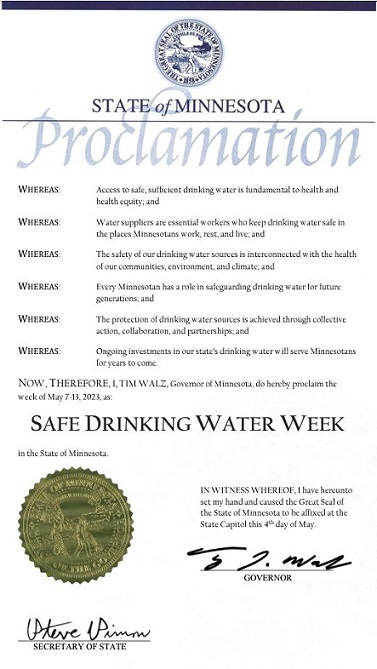
Go to top
Funding for lead service line replacements and other resources
In addition to the $240 million allocation from the state of Minnesota for the replacement of lead service lines, the federal Infrastructure Investment and Jobs Act - also known as the Bipartisan Infrastructure Law - provides approximately $40 million per year for five years for replacement projects.
Public water systems may apply through the Drinking Water Revolving Fund.
Priority will be given to areas with children under the age of five and/or children with elevated blood lead levels and areas with lower-income residents or disadvantaged communities. In addition, removal of lead service lines that are an imminent threat to public health and safety will be prioritized as will the replacement of lead service lines in coordination with watermain replacement projects.
Water systems are encouraged to apply for funding as soon as their lead service line inventories are complete. The University of Minnesota has a mapping tool that can help with these inventories.
MDH estimates that there are approximately 100,000 lead service lines in the state. “Safe, clean drinking water is a foundational human need, and it is long past time we make it a reality for all Minnesotans,” said Governor Walz when he signed the legislation.
Lead service line inventories due October 16, 2024
As mandated by the federal Safe Drinking Water Act, all community and nontransient noncommunity water systems must prepare an inventory of all service lines (including those not in use) that are connected to water mains. These inventories, which are due to the Minnesota Department of Health by October 16, 2024, must include a location identifier and the material of the service line.
The first step in a process to remove lead service lines, the inventories will be regularly updated as additional information becomes available and as lead service lines are removed and replaced.
More information: MDH Quick Reference Guide for Lead Service Line Inventories
Go to top
Dewatering added to long history of Moorhead water treatment
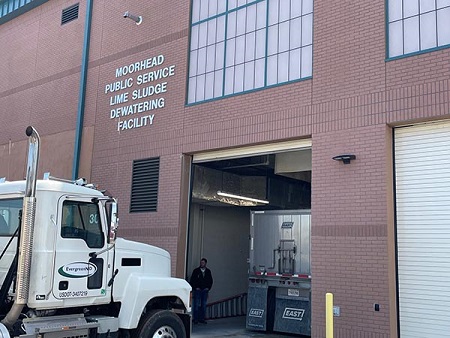
The new dewatering plant in Moorhead operates with a plate-and-frame filter press.

A new chapter in a lengthy history of providing water in the Red River Valley has come to Moorhead, Minnesota, the first city on the Red River of the North to draw surface water for treatment, beating out Fargo, North Dakota, by about 1,300 feet.
Nearly unnoticeable in tame times, the Red River has been a miles-wide lake in times of high water. Although stable for the most part, the Red River can be an unreliable source of drinking water. Moorhead Public Service (MPS) has expanded over the decades to include multiple surface water and groundwater sources to ensure reliable service to its customers and flexibility in its operations.
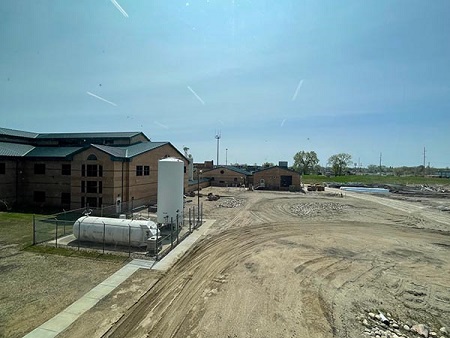
The existing plant is to the south of the new dewatering building.
Geology
Geologic history, physical properties, and land use define water characteristics of this area. The extreme western regions of northern Minnesota are topographically flat with soils that are heavy in clay that drain poorly. The topography and underlying drift are related to the last glacial period, which retreated from the state approximately 10,000 years ago. Minnesota’s most prominent glacial lake was Lake Agassiz, which was larger than all of today’s Great Lakes combined. Lake Agassiz occupied the northwest portion of Minnesota, providing settling points for silt and clay, which impede the movement of groundwater.
Long before this, salt-water bodies invaded the region and left a sheet of marine sediments, including sandstones, shales, and limestones. A period of erosion followed the withdrawal of the ancient seas, but during the Cretaceous period the area was occupied by another sea that left sediments tilted gently toward the west. Near the Red River, which serves as the boundary between North Dakota and Minnesota, the presence of the Cretaceous beds is still evident by the saltiness of the water derived from them and contributes to high total hardness and dissolved solids in area source waters.
Larry Cole, a former Minnesota Department of Health district engineer, explained why a water supply adjacent to the Red River is so challenging: “There are two factors involved: the shallow soils that are heavy in clay and fertile, making the Red River Valley the breadbasket of the world, but aren’t the sort of thing to develop a water supply in. And the deep soils have the old sea-bed water in them. The upper soils don’t yield water; the lower soils are salty.”
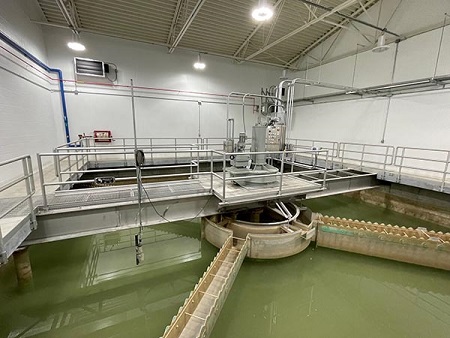
Water from the thickening basin (above) goes to the plates, which are compacted by a hydraulic ram (below).
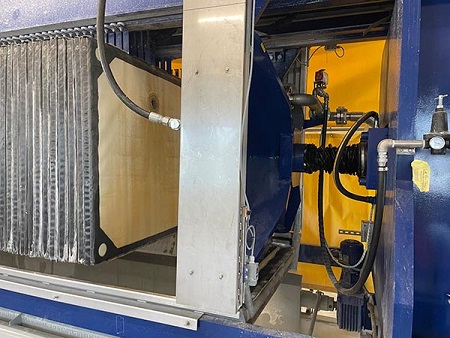
Moorhead Water History
Prior to 1900, Moorhead had once used untreated surface water to supply its citizens with water. At the turn of the last century, cholera and typhoid outbreaks associated with raw surface water prompted the city to switch to aquifers around 1905. Moorhead supplied 100% of its water needs via groundwater for the next 50 years.
In 1950, Moorhead built its first treatment plant, specifically designed to soften groundwater. The facility was centrally located between multiple wellfields that tapped into the Moorhead and Buffalo aquifers, about three miles east of the Red River. In 1959, the utility tripled its capacity with a plant expansion that added surface water back into its water supply portfolio, including a new Red River intake structure, pump station, and transmission pipeline.
Because of taste and odor problems associated with the river, Moorhead historically drew 60 percent of its annual flows from the Red River. Well water produced a blend, diffusing the river water and improving its aesthetic quality. In addition, the cool groundwater helped offset the river water temperatures, which could be 80 degrees in the summer.
In the 1980s MPS looked at further expansion to accommodate residential growth and increased industrial demand. Anticipation of more stringent standards for disinfection byproducts prompted a look at getting away from free chlorine, which had been added before and after filtration in previous treatment systems.
A transition to monochloramines would reduce the disinfection byproducts, but MPS envisioned more. Ozone as a primary disinfectant could not only keep down the trihalomethanes and haloacetic acids, it also controlled taste and odor problems, allowing the utility to increase its use of the river and leave the limited groundwater supplies as a secondary or backup source. Thus, when the “New Plant” went on-line in late 1994, Moorhead increased is capacity to 16 million gallons per day and became the first city in Minnesota to use ozone. (It remains the only city to do so, although others are now considering or implementing it.) By introducing ozone as its main disinfectant, MPS reduced its use of chlorine by more than 50%, thereby easily meeting the standards for disinfection byproducts, and it discontinued free chlorine altogether via the use of chloramines for post-disinfection.
Twenty-first Century Challenges
In 2015, the Minnesota Pollution Control Agency (MPCA) reclassified lime solids, a residual from the softening process, as industrial solid waste. MPS has 12 existing storage ponds for lime, all of which were approaching their storage capacity. At the time, MPS was in process of distributing requests for proposals for additional pond construction, but the reclassification prompted them to quickly look at other options.
“It was ‘go time’ from there,” said water plant manager Marc Pritchard, adding that the storage and disposal process would become much more expensive with the additional restrictions of the MPCA ruling.
Instead of opting for new ponds that would need to be dredged every third year, MPS decided to construct a dewatering facility to the north of its treatment facility. Construction began in early 2020, “just before the world changed,” according to Pritchard, referring to the global pandemic that made all aspects of life trickier. Working through a variety of COVID related challenges, construction stayed on track and was completed in 2021. “You just have to adapt. And they did,” said John Thom of SEH, Inc. of Vadnais Heights, Minnesota, which designed the dewatering plant.
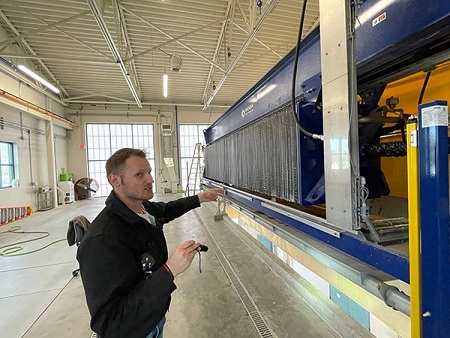
Marc Pritchard (above) explains the dewatering process. Ryan Knutson (below) oversees one of the press cycles.
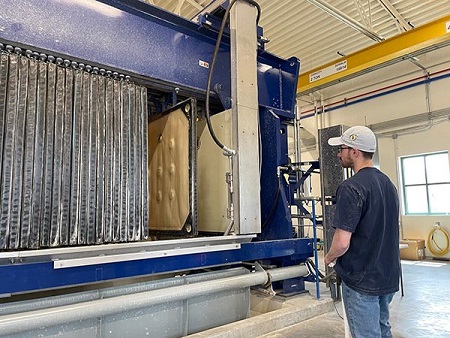
The new dewatering process uses a plate-and-frame filter press with a hydraulic ram to force the plates of the press together. Lime residuals from the softening basin in the main treatment facility are piped to the new building’s thickening basin on the upper level and then into each of the spaces between the plates in the new filter press. MPS lead operator Jason Yonke said the 116 plates end up with 8-1/3 cubic yards of dewatered lime per cycle. The plates are separated one at a time with the dewatered lime “cake” dropping through bomb-bay doors into the bed of a truck on the first level. The truck is full after three press cycles for a total of approximately 25 cubic yards.
At this point, a driver pulls up to the facility with an empty truck, pulls the full truck outside, brings the empty truck in, and drives the full truck away. The swap of trucks takes place twice a day with the dewatered lime solids taken more than 120 miles to central Minnesota and used for land application. Disposal is the biggest cost, although the operational costs are lower than the long-term requirements of repeated dredging of additional storage ponds.
Although the process is now achievable with just one filter press, the building was constructed with room for another press with an additional truck bay below.
Spanning three different centuries in supplying drinking water, Moorhead Public Service has stayed flexible, incorporating new technologies to meet demand and respond to changing conditions and regulations.
Did You Know?
The Moorhead Armory was to be the site of a concert in February 1959 that was canceled when the en-route musicians—Buddy Holly, Ritchie Valens, and the Big Bopper—were killed when their plane crashed after takeoff in Clear Lake, Iowa.
Go to top
Alycia Overbo heads new unit and other MDH people news

Alycia Overbo at the entrance to Yellowstone National Park.
The Drinking Water Protection Section at MDH has formed the Communications and Strategic Initiatives Unit, which will be supervised by Alycia Overbo.
A native of Devils Lake, North Dakota, Alycia became interested in water at a young age because of the decades of flooding in that region. “The lake has swallowed up entire neighborhoods, farms, and communities in that area,” she explains, adding, “I studied science and dabbled in music at St. Olaf College, and was a Peace Corps volunteer in Mozambique for two years, where I taught biology to eighth graders in Portuguese. After Peace Corps, I focused on drinking water, environmental public health, and chloride pollution in my graduate studies and research at UNC-Chapel Hill and the University of Minnesota. Science communication, education, and health equity have been the through-lines in my work experiences, and I’m really passionate and excited about our new program.”
Alycia plays violin and piano along with tinkering with the accordion. She enjoys making and appreciating art, occasionally quilts (“poorly,” she says), and is always up for a trip to the Boundary Waters with friends.
Alycia has one cat (Bandit), one dog (Honey), two kids (Renata, 6, and Roman, 2), and one husband (Brad).
Comings and goings
After 43 years with MDH, Mike Luhrsen has called it a career. Working out of Duluth, Mike was the long-time district engineer in northeastern Minnesota. In addition to working with water systems in the area, Mike was active in the ongoing training of water operators in the area.
Todd Johnson is the new Drinking Water Revolving Fund coordinator, succeeding Chad Kolstad, who is now the supervisor for the newly created Drinking Water Infrastructure Unit.
Dylan Heise joined the Drinking Water Protection Section as an engineer who will be doing plan review for drinking water projects.
Born and raised in St. Paul, he also lived in Mexico for half a year. His professional background is in manufacturing and automation.
Dylan’s family includes a pair of parents in Kettle River, Minnesota, and a kitty, Tipper.
 Sara Mollamohammada has joined the section as a graduate engineer who will be reviewing plans and specifications related to the replacement of lead service lines and assisting in the implementation of the Drinking Water Revolving Loan Fund.
Sara Mollamohammada has joined the section as a graduate engineer who will be reviewing plans and specifications related to the replacement of lead service lines and assisting in the implementation of the Drinking Water Revolving Loan Fund.
Sara is from Iran and has been living in the United States for about 11 years. “I’ve dabbled in both government and academic careers,” Sara says, “with my recent career being teaching at University of St Thomas. I love traveling, and I recently came back from Squamish in Canada."
She has a spouse and a cat, Bella, shown with Sara (Bella, not the spouse).
 Tareq Bastawisy is an engineer working with water quality parameters and lead and copper. From Egypt (with a home residence of Bahrain), Tareq attended the University of Minnesota, getting his bachelor’s degree in chemical engineering and his master’s in environmental engineering.
Tareq Bastawisy is an engineer working with water quality parameters and lead and copper. From Egypt (with a home residence of Bahrain), Tareq attended the University of Minnesota, getting his bachelor’s degree in chemical engineering and his master’s in environmental engineering.
Tareq’s hobbies are video games and painting, but (despite the photo to the right) not fishing. He loves to cook, especially with seasonal food, and listen to music with languages he doesn’t understand. He can also read Japanese and Russian.
 Brian Rivers is an engineer working with contaminants of emerging concern. A native of Winona, Minnesota, he got his degree in civil engineering from the University of Wisconsin, Platteville, and his master’s degree in environmental engineering at Michigan Tech. Brian served in the Peace Corps in Peru and Engineers Without Borders in Ghana. In case you can’t tell from his picture, Brian is a major bicycle dude and once pedaled from Panama to Peru to Patagonia.
Brian Rivers is an engineer working with contaminants of emerging concern. A native of Winona, Minnesota, he got his degree in civil engineering from the University of Wisconsin, Platteville, and his master’s degree in environmental engineering at Michigan Tech. Brian served in the Peace Corps in Peru and Engineers Without Borders in Ghana. In case you can’t tell from his picture, Brian is a major bicycle dude and once pedaled from Panama to Peru to Patagonia.
 In case you can’t tell from her picture, Allison Dodge is a major “bird nerd” (her words) and now moonlights as a compliance officer in DWP. She grew up in Apple Valley and got her degree in biology at Minnesota. She worked in the zookeeping field for five years before joining us and worked for a zoo training facility that did the shows at Walt Disney World. She was a bird trainer and did the bird shows at the Minnesota Zoo. She alerts visitors that they will find bird feathers on her desk. Allison also hosts trivia on Thursday nights at Union 32 Craft House in Eagan.
In case you can’t tell from her picture, Allison Dodge is a major “bird nerd” (her words) and now moonlights as a compliance officer in DWP. She grew up in Apple Valley and got her degree in biology at Minnesota. She worked in the zookeeping field for five years before joining us and worked for a zoo training facility that did the shows at Walt Disney World. She was a bird trainer and did the bird shows at the Minnesota Zoo. She alerts visitors that they will find bird feathers on her desk. Allison also hosts trivia on Thursday nights at Union 32 Craft House in Eagan.
Micaileigh McBride is a compliance officer, working with nitrites, nitrates, disinfection byproducts, and inorganic and organic chemicals. Husband-free and child-free, she lives in St. Louis Park with her partner, Phill.
Micaileigh is from Inyokern, California, near Death Valley and the Mohave Desert. She moved to Minnesota in January 2018 and liked the cold so much that she stayed after graduating. She worked as a preschool educator, so her new position at MDH is a change of pace for her, fitting in more with her degree in public health.
Micaileigh enjoys hammocking, finding new spots to eat, and traveling, which includes recent trips to Amsterdam, Germany, and Italy (twice).
Go to top
Scandia draws on its roots with reconstruction of Water Tower Barn
Heritage association looks to develop water-focused center

Frank Lake's mercantile from the 1890s lives on as the Scandia Market & Mercantile.
Transplanting Dakota and Ojibwe people in the area, Swedish immigrants settled in a region 35 miles northeast of the Twin Cities beginning in the 1850s. With a name reflective of its Scandinavian heritage, New Scandia Township eventually became the city of Scandia, the status change because of concerns of annexation by Forest Lake, its neighbor to the west. According to a historical marker in town, by 1920 nearly a quarter of Minnesota’s foreign-born residents were from Sweden, making it the home of more Swedes than any other state.
As for those who ended up in Scandia, the city’s web site says, “Many of these settlers came by way of New York City, making their way to the St. Croix River and finally Log House Landing, where they [were] greeted [by] a landscape reminiscent of their homelands – land that had been ceded by Dakota tribes in the Treaty of 1837.”
With its eastern boundary extending to the St. Croix River between Taylors Falls and Stillwater (see map below), Scandia covers an area of nearly 40 square miles. Most of its 4,000 residents are clustered in a section around Olinda Trail and Minn. Hwy 97.

Rather than a municipal water system, Scandia is served by individual wells and a number of private enterprises, Scandia Water Company and Hilltop Water Company being the primary ones. Drinking water from these two systems comes from a pair of wells approximately 300 feet deep into the Jordan and Prairie du Chien-Jordan aquifers. The roots of the city’s private water supplies can be traced to the early years of the Swedish influx.
History
Out of the early dairy farmers who helped one another to survive, set up a church, and generate a few businesses, it was the second-generation immigrants who promoted area commerce. The most notable was Frank Lake, who opened the Scandia Farmers Store (later called the Scandia Mercantile) on the northeast corner of Two Church and Boney Lake roads (now Olinda Trail and Oakhill Road, respectively). Lake’s store sold everything from fashions to farm equipment.
The Mercantile still exists on this spot. Behind it is a replica of a barn and tankhouse built by Lake on the site, the replica housing pipes and pressure tanks with a well outside it. The original structure was dismantled nearly 10 years ago with the logs photographed and cataloged. The Scandia Heritage Alliance hopes to reconstruct the building a couple of blocks to the south and have it as the highlight of a regional arts and heritage center. Alliance board chair Sue Rodsjo says the center will have a water theme with historical displays and educational activities. “It will demonstrate to the public the 19th century ingenuity and engineering that was used.”
The ingenuity refers to the barn and tankhouse Lake built to serve local businesses and the community. Tankhouses were typically built by railroads and municipalities, but Scandia’s was built by a local entrepreneur. “Before local farmers had the means to dig their own wells, they often had cisterns that could be filled with water from the tankhouse,” Rodsjo explained, adding, “It was unique that it was run by a local resident.”
The Aermotor Windmill
Lake built the barn to stable his delivery horses and added a windmill to pull water into the elevated tankhouse. He used wooden pipes for water supply to his store and to his neighbors. A horse-drawn wagon delivered water to outlying homes and farms, allowing the burgeoning community to flourish.
The Aermotor windmill was becoming a familiar sight through the Midwest and achieved even greater prominence at the 1893 Chicago World’s Fair. Lake purchased the Aermotor all-metal wind-powered pump for his water supply. The well on the site was partially under and adjacent to the barn, and the windmill powered a long rod to bring water to the tower. The heritage alliance still has that rod, which will be used in the rebuilt barn and tankhouse along with the original clapboard siding, barn doors, and the post-and-beam structure.
The windmill was gone by the end of the 1930s, made obsolete by rural electrification, but water still flows from the barn’s well to local customers. In addition, the barn’s distinctive cupula – built to support the windmill – remained part of the gable-roofed structure. Different windmills were used through the decades, and one will be included on the rebuilt barn and tankhouse. Rodsjo said they are looking at replicating the windmill from the 1920s, which was during the self-oiling era.
Current Project
At the time that the structure was taken down in 2014, the Hilltop Water Company had underground pressure tanks. A source water protection grant from the Minnesota Department of Health (MDH) helped the utility to dig up the tanks and fill in the ground. Above-ground tanks were installed on the same site and housed within a replica of the original bank and tankhouse, constructed at about one-quarter the scale of the original. The well is just outside the replica building.
With the dismantling of the original Water Tower Barn, the Scandia Heritage Alliance received a $10,000 grant from the Minnesota Historical Society to research the history, engineering, and design of the tankhouse, pump, and windmill construction. The tankhouse is believed to be the only one remaining in the state, and the alliance is seeking to have it placed on the National Register of Historic Places.
The city recently was awarded $2.2 million from the state bonding bill for the arts and heritage center as well $2.68 million through the Legislative-Citizen Commission on Minnesota Resources for an extension of the Gateway Trail through Scandia.
According to the alliance, “The restored barn will showcase 19th-century craftsmanship, including hand-hewn logs in a post-and-beam structure, and an operational tankhouse. An elevated wooden water tank will occupy the tower, and a windmill will sit atop the barn’s cupola.”
The Water Tower Barn Arts & Heritage Center will include an indoor stage and outdoor amphitheater, a water play area, trails, and a wetland overlook. The center’s water focus will educate visitors with interpretative displays on the importance of its wetlands, lakes, streams, aquifers, and the St. Croix River.
If all that is somehow not enough, Rodsjo said an additional focus on water will be a historic hand pump, which visitors may use to fill their water bottles.
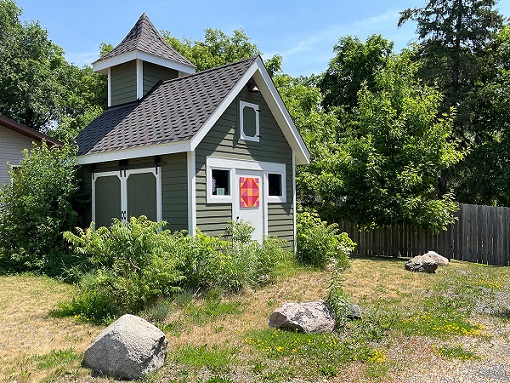
Above: The replica of the barn and tankhouse.
Below: An artist’s rendition of the rebuilt structure.
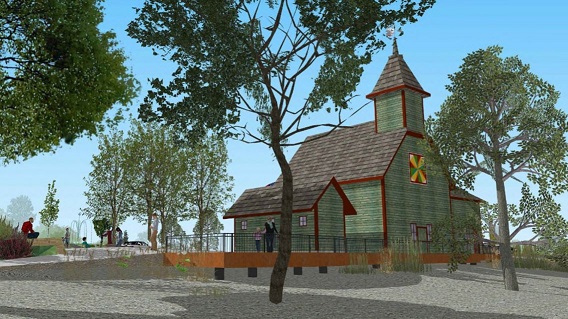
Go to top
Quote of the quarter
“Dare to be different on the side of simplicity.”
Go to top
Reminder to all water operators
When submitting water samples for analyses, remember to do the following:
- Take coliform samples on the distribution system, not at the wells or entry points.
- Write the Date Collected, Time Collected, and Collector’s Name on the lab form.
- Attach the label to each bottle (do not attach labels to the lab form).
- Include laboratory request forms with submitted samples.
- Do not use a rollerball or gel pen (the ink may run).
- Consult your monitoring plan(s) prior to collecting required compliance samples.
Notify your Minnesota Department of Health district engineer of any changes to your systems.
Go to top
Calendar
Operator training sponsored by the Minnesota Department of Health and Minnesota AWWA will be held in the coming months.
Register for schools and pay on-line:
Go to top